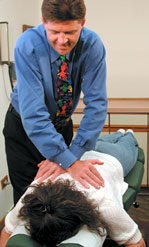
Adjustments and the Chiropractic Lifestyle
Every chiropractic adjustment is tailored to each patient.
A chiropractic adjustment is the use of a specific force in a precise direction, applied to a joint that is fixated, “locked up”, or not moving properly. Adjustments help return bones to a more normal motion or position, relieving pain and ill health.
Years of experience insure that each adjustment is precisely delivered.
Chiropractic adjustments are so safe, even newborns and children can receive adjustments to repair the damage caused from the birth process, learning to walk, or other childhood trauma.
 There are many ways to adjust the spine. Usually the doctor’s hands or
a specially designed instrument is used to deliver a highly accurate
thrust. After years of training, each doctor has selected a variety of
methods and has become skilled in their delivery. Regardless of the
technique used, each chiropractic adjustment is tailored to the
patient’s age, size, and unique spinal problem.
There are many ways to adjust the spine. Usually the doctor’s hands or
a specially designed instrument is used to deliver a highly accurate
thrust. After years of training, each doctor has selected a variety of
methods and has become skilled in their delivery. Regardless of the
technique used, each chiropractic adjustment is tailored to the
patient’s age, size, and unique spinal problem. Adjustments help normalize spinal function and joint mobility. When nervous system function improves in this way, the body can begin the natural healing process.
What is an adjustment?
A chiropractic adjustment is the use of a specific force in a precise direction that helps normalize spinal function.
When the 24 bones that protect the spinal cord lose their normal position or motion, delicate nerve tissue can become choked or irritated. If a thorough examination reveals malfunctioning areas of the spine, chiropractic adjustments are recommended to help correct this condition.
Each day, millions of delighted patients choose chiropractic over drugs or surgery, as a common sense approach to better health.
THE CHIROPRACTIC LIFESTYLE
Chiropractors are experts in the care of the bones, nerves, muscles and connective tissues that make up about 60% of your body. All of the joints in your body are part of this musculo-skeletal system and its optimal function is necessary for overall good health. Ask your Doctor of Chiropractic for more information about a care program that may include specific spinal adjustments, exercise recommendations, nutritional advice or other conservative methods of care based on your health history, age, current condition and lifestyle.
REFERENCES:
Hadler, N. M., et al, A Benefit of Spinal Manipulation as Adjunctive Therapy for Acute Low Back Pain; A Stratified Controlled Trial, 12 (7):703-706, 1987.
Kirk, R., D.C., Lawrence, D., D. C., Valvo, N., D. C., States' Manual of Spinal, Pelvic and Extravertebral Technics, 2nd edition, National College of Chiropractic, 1985.
Kirkaldy-Willis, W., M.D., Managing Low Back Pain, 3rd edition, Churchill Livingstone, 1993.
Leach, R., The Chiropractic Theories; A Synopsis of Scientific Research, 2nd edition, Williams and Wilkins, 1986.
New Zealand Report; Report of the Commission of Inquiry, Government Printer, Wellington, New Zealand, 1979.
Schafer, R., D.C., Faye, L., D.C., Motion Palpation and Chiropractic Technique, 2nd edition, Motion Palpation Institute, 1990.
Webster, L., D.C., Subluxation; Birth and Early Childhood, International Pediatrics Literature, March, 1989.
©2002 Back Talk Systems, Inc.
(800) 937-3113 (303) 277-9990
www.backtalksystems.com
(800) 937-3113 (303) 277-9990
www.backtalksystems.com

